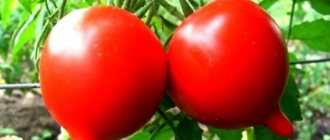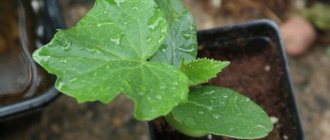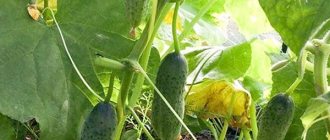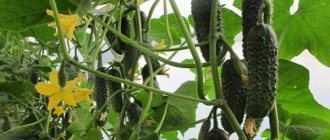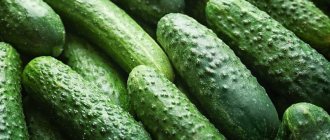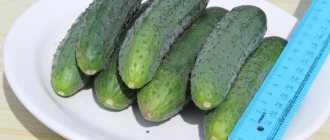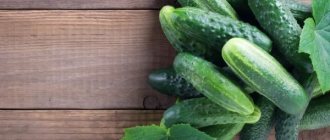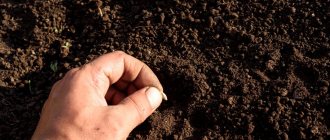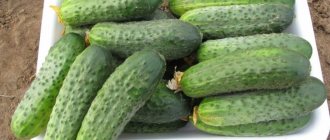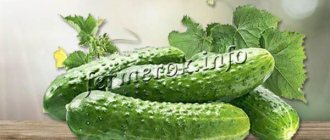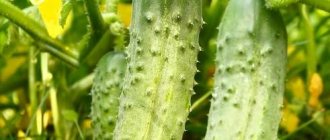Description of the variety Murashka F1
Murashka F1 cucumber is a first generation parthenocarpic hybrid. It was created in the agro division. In 2003, it was entered into the State Register of Russia, but work to improve it continued for several more years. Today this is one of the favorite hybrids of gardeners. You can grow cucumbers of this type in open ground, greenhouses, greenhouses, on a balcony or veranda.
Cucumbers need 43 days to ripen. The central stem is indeterminate. Few side shoots are formed and they grow small. Internodes are short. The leaves are medium in size, with a smooth leaf blade, and light green in color. 4-6 fruits can begin in the axils of the leaves.
Zelentsy grow small, 11-13 cm long and weighing 90-110 g
Important!
Hybrid Murashka F1 cannot be propagated by seeds obtained from grown cucumbers. Seeds for planting need to be purchased in stores annually.
Cucumbers grow small, 11-13 cm long and weighing 90-110 g. Cucumbers grow in the shape of a cylinder. The tubercles on the greens are large, with black spines. The skin is green, but the tip area is light green. The taste is pleasant, with a sweet aftertaste.
Nuances of care and cultivation
Murashka is grown by direct sowing or through seedlings, which allows for an earlier harvest.
The hybrid is very demanding on soil quality. Light soils must also be fertile, otherwise there will be no fruiting. Therefore, loamy or sandy loam substrates are determined for Murashka. He loves cucumber humus very much.
The area allocated for cultivation should have good lighting and protection from cold gusts of wind. It is strictly not recommended to plant plants in lowlands where water stagnates and the air is damp and cool.
You need to prepare the beds in the fall:
- When digging deeply, weeds are carefully removed;
- Add 2 buckets of humus for every 1 m²;
- Add nitrogen, potassium and phosphorus fertilizers;
- The beds are poured with boiling water and covered with film until spring.
When the shoots appear, a primary culling is done: deformed, weak sprouts are carefully cut off with scissors. With this manipulation, the roots of a healthy plant will not be damaged.
Seedlings are placed in the most illuminated places, and additional lighting is turned on if necessary.
Seedlings are not planted earlier than 25 days of age. Younger, she is very tender, weak and sensitive. Even a slight decrease in the usual air temperature can destroy it.
The beds are pre-watered abundantly, only then the holes are made. The Murashka hybrid can be placed in a checkerboard pattern or in a row, the main thing is to maintain an interval of 70 centimeters.
The plantings are again watered abundantly, and after absorbing the water they are mulched. Further care is the same as for most hybrids.
Growing this hybrid is no different from growing other varieties of these beloved vegetables. You can try the seed cultivation method, or you can get seedlings first. In the first case, the seeds should be prepared and processed - heated at a temperature of 50 ᵒC for 3 days, and then soaked in a manganese solution.
The seedling method is the most preferable, as it allows you to start harvesting much earlier. To do this, the hatched seeds are placed in separate peat pots and all the necessary conditions for growth are created, and when 2-3 leaves appear, they can be transferred to a permanent place, simply tearing off the bottom so as not to injure the delicate root system of the plants.
A place must be chosen that is well lit and protected from negative environmental conditions. The most suitable soil for cucumbers is light loamy, and the place should be away from potatoes, fennel and other aromatic herbs, except dill.
2–3 bushes are planted per 1 m², but before that the soil should be properly prepared by applying fertilizer. It is best to choose a square-nest planting method, which will make planting and further care of plants easier.
What should you pay special attention to?
It is necessary to fertilize at least three times during the entire growing season. For this, a solution of mullein, superphosphate, and ash is used. Judging by the reviews, goosebump cucumbers are loved by many gardeners. They noted their resistance to diseases, the absence of barren flowers, and excellent taste.
Some argue that the hybrid is capable of bearing fruit until frost, which is also its undoubted advantage. If you wish, you can pick young pickles and enjoy home-made gherkins all winter.
This is such a wonderful variety. You have the opportunity to get to know it better and recommend it to your friends and acquaintances for cultivation. Good luck!
Oksana Shavyrina
Characteristics of cucumbers
Also check out these articles
- Strawberry variety Gigantella
- Straw (hay) chopper
- Which sheep clipper to choose
- Apricot variety Academician
Cucumbers of the Murashka F1 variety are among the sought-after species. What qualities are they chosen for?
- The hybrid is early ripening, self-pollinating.
- Plants are suitable for growing in open and closed ground.
- Unpretentious to soil and care. This variety can be grown on any type of soil, as long as the acidity is neutral.
- Murashka F1 cucumbers do not produce barren flowers.
- The hybrid is immune to many diseases.
- The taste is pleasant, rich, without bitterness. Murashka cucumber is suitable for preparing preserves, pickling and salads.
Murashka F1 cucumbers do not produce empty flowers
Important!
Only with proper care can you get a large harvest of Murashka F1 cucumbers.
- Productivity is high, fruiting is extended. From each bush you can remove up to 7 kg of greens per season.
- The crop is suitable for transportation over long distances.
- Zelentsy of commercial quality.
Gardeners also consider the fact that the hybrid does not require pollination to be a huge advantage. Cucumbers grow in large quantities even indoors, which is very convenient.
Cucumber April F1
This is an excellent early ripening hybrid, self-pollinating, but for a better harvest it should be additionally pollinated in the first month of fruiting. About 45 days pass from germination to active fruiting. On average, one square meter yields up to 25 kilograms of cucumbers. The April F1 cucumber is very popular among gardeners for its consistent fruiting. This is very convenient when preparing cucumbers for the winter. In the first month of fruiting, cucumbers produce about 95% of the total harvest. But for those who plant vegetables for salads, it is more convenient to choose a different variety. In addition, this variety is susceptible to white rot.
Medium climbing plant. The ovary is cylindrical in shape, the surface is smooth, without pronounced grooves. The taste is good.
Disadvantages of the Murashka hybrid
Murashka F1 cucumbers also have disadvantages, but there are not many of them.
- The plant is indeterminate - the main vine grows very long, so it is difficult to grow this variety without good support or trellis.
- The hybrid is susceptible to a disease such as peronosporosis. He often suffers from root rot.
- You cannot propagate Murashka F1 with seeds collected from grown green plants, because it is a first-generation hybrid.
You cannot propagate Murashka F1 with seeds collected from grown green plants.
It should also be taken into account that when growing these cucumbers using the seedling method, the yield will be higher. If you sow seeds immediately in open ground or in a greenhouse, the plants will take longer to develop and the yield will decrease.
Important!
Crop yields are negatively affected by sudden temperature changes between night and day.
Advantages and disadvantages
The fact that Murashka F1 has been in demand for so many years in a row became possible thanks to its undoubted advantages:
- Precocity . The ability to quickly harvest allows the hybrid to be used for commercial purposes.
- Versatility of cultivation . Cucumbers can be grown not only in greenhouses and open ground, but also on the balcony or windowsill.
- Parthenocarpy . The flowers are female, there are practically no barren flowers.
- Good external characteristics . They help in commercial use.
- Ability to quickly regenerate . If a separate lash or even the main shoot of a bush is broken, this zone is restored very quickly.
Related article:
What's wrong with cucumbers?
But there are also certain disadvantages :
- dependence on weather conditions;
- need for molding;
- impossibility of collecting seed material.
Cucumber seedlings Murashka F1
We recommend reading our other articles
- Carrot variety Shantane
- Large white pig breed
- Bee wax
- The best varieties of eggplants for open ground
Sowing seeds for seedlings in central Russia is carried out from the last days of March to mid-April. But before that, they are heated near a radiator at a temperature of +25 degrees and soaked in water to germinate. You can also disinfect the seeds by treating them in a solution of potassium permanganate (weak).
To grow seedlings, you need to purchase peat or paper cups, pots with a diameter of at least 12 cm. The soil is made from 1 part garden soil, 1 part peat. For 10 liters of this mixture, also take 2 cups of wood ash and ¼ cup of superphosphate. The cups are filled with soil, shallow holes are made with a pencil, and the seeds are placed, sprinkled with no more than 2 cm of soil. You can put 2 grains in each glass.
In order for seedlings to grow quickly and not get sick, it is necessary to fertilize them in a timely manner.
The finished cups with seeds are placed in a common tray and covered with film. Seeds germinate best at a temperature of +25…+30 degrees. After germination, the tray with cups is placed on the south window and the film is removed. The temperature is reduced to +20 degrees. On all cloudy days, it is necessary to provide additional lighting with a lamp.
Important!
If Murashka cucumber seeds are processed by manufacturers (dyed), they do not need to be heated or soaked before planting. Any treatment, even against diseases, will harm such seeds!
In order for seedlings to grow quickly and not get sick, it is necessary to water them in a timely manner, add soil, and, if necessary, fertilize them. Fertilizer is applied once, after 2 leaves appear. It is made from a liter of water and a teaspoon of nitroammophoska. The second option is to buy Zdraven Turbo fertilizer and use it according to the instructions.
Growing
In order for the harvest to please you with its results, you need to study the description of the variety and the secrets of cultivation. To sow seeds of this variety of cucumbers directly into the soil, it is necessary to wait for complete warming and warming of the earth to a depth of at least 12-15 cm. Before planting, the seeds should be treated with potassium permanganate (5 grams per half liter of water) and soaked for 12-20 hours. To grow seedlings of the hybrid variety Murashka, the steps with seeds are the same.
After all the manipulations, in order for the sprouts to hatch, it is necessary to place the cucumber seeds on a wet cloth and maintain the moisture at a temperature of at least 25°C. As soon as the Murashka cucumber seeds hatch, they should be moved to prepared soil consisting of equal parts of turf soil and humus. You need to add a glass of wood ash to a bucket of such a mixture and fill individual cups with 2/3 of the total volume, making sure that there are drainage holes.
Perennial marigolds planting and care, growing from seeds: when to plant Chernobrivtsy in open ground, medicinal properties and photo tagetes
Cucumber seeds should be placed to a depth of 1 cm in a well-moistened mixture. Place in a large box, add a small layer of soil to the bottom, cover with glass or film and place in a sunny place.
Murashka cucumber seeds germinate slowly, do not worry if they do not appear within 2-2.5 weeks. At the first appearance of sprouts, it is worth removing the film and lowering the temperature to avoid stretching the stem.
You can feed Murashka cucumber seedlings with mullein (dilute 1 liter in 10 liters of water, then pour 1 liter of the resulting solution into 10 liters of water again).
When two true leaves appear, you can plant cucumber seedlings in open ground, preferably at the end of April, beginning of May. 2-3 bushes are planted per 1 m2, resulting in 10-12 kg of finished product. The soil for cucumbers of the hybrid Murashka variety should be well fertilized; it is advisable to distribute 2 buckets of humus per 1 m2 in the fall. Potatoes and various aromatic herbs, with the exception of dill, should not be nearby. You should choose the south side for full sunlight on the cucumber bush.
When sowing in greenhouses, the principle of preparing seeds of this hybrid variety Murashka F1 remains the same, but before the onset of consistently high temperatures, it is necessary to maintain heat and humidity at the proper level. When using the square-cluster method (in a checkerboard pattern), you should make holes at a distance of 70 cm, and put 8-10 cucumber seeds in each hole, having previously fertilized it. After germination, leave no more than three bushes of this variety; with the help of a support, distribute them evenly so as not to form a large density. If sowing is done in rows, the seeds of Murashka cucumbers are placed in the soil at a depth of 3-4 cm, at a distance of 5 cm from each other, for the further possibility of removing weak sprouts. You need to thin out regularly until there are 5 cucumber bushes left per 1 linear meter. In order for the harvest of the hybrid variety Murashka to surprise with the abundance of fruits, it is necessary to pinch the main stem of the bush after the 6th leaf, and the side stems at a distance of 40 cm from the trunk.
The temperature during active growth should not fall below 25°C, otherwise the roots of the plant may be damaged and the bush will begin to hurt. Considering that Murashka F1 cucumbers actively grow at night, it is also advisable to water them in the dark. The amount of water is based on 20 liters per 1 m2 to maintain the required humidity. During flowering, it is worth watering carefully to avoid moisture getting on the bush. For better penetration of oxygen into the soil, loosening is necessary after each watering.
It is necessary to fertilize at least three times:
- Fertilize with manure, in the same ratio as for seedlings. The color should be like weak tea.
- Add 1 tbsp to the previous fertilizer. l. nitroammofosk or superphosphate and distribute 1 liter for each bush. A prerequisite is to water the seedlings before fertilizing.
- With the help of ash (1 glass per bucket of water) fertilize 0.5 liters per bush just before the fruits ripen.
The hybrid variety Murashka 1 will become an indispensable crop in your garden, it will delight you with the taste of cucumbers and long-term fruiting, and the ease of cultivation will allow even a novice gardener to be convinced of this.
Features of planting the variety
Transplant seedlings to a permanent location at the end of May or beginning of June. The soil for cucumbers is dug up 2 weeks before transplanting. Then it is watered with a solution of 500 ml of mullein (liquid), a glass of dry droppings, a teaspoon of copper sulfate and 10 liters of water. At the time of planting, the soil should be warmed up to +15 degrees, but more is better. If it is cold, you can cover it with film after applying fertilizer. Thus, the soil will warm up faster.
Interesting!
If it is necessary to grow cucumbers by seeds and not by seedlings, the seeds are sown in May or June. You can sow 2-3 grains in each hole, and when they sprout, leave only one, the strongest sprout, removing the rest.
If the seedlings are in peat cups, they can be planted together with the container
Plant the seedlings at a distance of 50 cm from each other. The same distance is maintained between the rows. The holes are dug as deep and wide as cups in which seedlings grow. Then water is poured. It is very important that the planting depth is the same as when growing seedlings, no more. If you bury the sprout, it will begin to rot.
Planting is carried out by transferring sprouts from a cup into the ground. If the seedlings are in peat cups, they can be planted together with the container. All that remains is to cover the sprout with soil so that it sits tightly, water and mulch with compost or sawdust.
Important!
Murashka F1 cucumbers, like any other varieties or hybrids, do not tolerate transplantation well, so it is better to grow seedlings in separate peat or paper cups. Then during transplantation, they will not need to be pulled out of the container.
How to grow cucumbers yourself
Murashka f1 cucumbers are grown in two ways: seedlings and direct sowing in open ground. The first option gives the highest yield. A good harvest is also obtained in greenhouse conditions. But in any case, the seeds are disinfected by soaking in a 1% solution of potassium permanganate for 20-30 minutes. They are then washed, wrapped in damp cotton cloth and left until germination at a temperature of 25°C. As the seeds dry, they are moistened. When they hatch, they are placed in the refrigerator for hardening for 18 hours at a temperature of 2°C.
Seedling method
After germination, the seeds are placed in soil made of soil and humus mixed with wood ash. The grains are embedded to a depth of 1 cm in separate containers with drainage holes and covered with film.
It takes two weeks for the seeds to germinate. Then the film is removed and the air temperature is reduced so that the plant stems do not stretch. As a top dressing, use a solution of “Nitroammofoski” (20 g of powder per 10 liters of water).
They are planted in open ground on the south side of the site so that the crop receives more sunlight. For the growth and development of cucumbers, the proximity of plants plays an important role.
The crop is not planted next to potatoes, radishes, radishes and tomatoes. Also, cucumbers are not grown in the same place year after year. Experienced vegetable growers change the bed each time, choosing a place without drafts.
Seedless method
To sow seeds directly in open ground, wait until the soil warms up to a depth of 15 cm to 18-23°C. The weather should be warm, without sudden frosts. First, the seed material is prepared: sorted, germinated, and hardened. The technique for preparing seeds is similar to preparing for planting seedlings.
The prepared grains are planted in the holes. They are made at a distance of 70-80 cm from each other. About nine seeds are placed in the depressions and sprinkled with a little soil. When shoots appear, leave 2-3 of the strongest plants and tie them to a support. The planting should not be thickened.
Growing and care
Murashka f1 cucumbers mainly grow at night, so they try to water them at this time. Plantings are moistened at the rate of 20 liters of water per 1 sq. m. When flowering, do not allow moisture to enter the bushes. Plants also need oxygen, for which purpose the soil is loosened after watering.
Fertilizers are applied three times:
- The first feeding is done during fruit set. Mullein is used for this.
- Fertilize with a solution of manure with the addition of superphosphate.
- Before the cucumber begins to yield, the plant is fertilized with ash.
As cucumbers grow, they need to be pinched and pinched:
- When the planted bushes take root and begin to grow, they are tied to a support.
- At the bottom of the bush, “blinding” is carried out: four true leaves are removed.
- When the vine reaches 0.5-1 m in height, the side stems are pinched, leaving one ovary and the accompanying leaf.
- With the appearance of the seventh leaf (distance from the soil surface - 1-1.5 m), the side shoots are pinched after 2-3 ovaries with leaves.
- Pinch the top. After this, all the plant’s energy goes into the side shoots, which has a positive effect on the amount of harvest.
Diseases and pests
Murashka cucumber f1 is a capricious plant. If preventive measures are not taken, the crop may be susceptible to disease. Protection is carried out with special chemicals or folk remedies:
- To combat powdery mildew, the preparations “Quadris”, “Jet” or “Topaz” are used.
- Bordeaux mixture or Quadris will help with anthracnose.
- Cucumber mosaic is treated with Actellik or Aktara.
- With a white or green mottled mosaic, the cucumbers are sprayed with skim milk.
- If the first signs of downy mildew appear, the plants are treated with Kuproxat or Ridomil Gold.
- With the appearance of the first signs of cladosporiosis, copper oxychloride is used.
- To prevent root and white rot, use “Fitosporin-M”.
- To get rid of aphids and spider mites, plants are sprayed with a soap solution (2 cups of ash and 200 g of grated laundry soap are mixed in 10 liters of water).
It is easier to prevent any disease than to treat it. Following these recommendations will help you grow a good harvest and provide the whole family with fresh cucumbers and winter supplies.
Rules for caring for Murashka cucumbers
Without proper care, you won’t be able to grow delicious, juicy Murashka cucumbers. So, what care does this plant need:
- It is best to grow Murashka cucumber on a trellis. Thus, space on the site is saved, and sunlight penetrates inside the bush, heating the stems and ovaries.
It is best to grow Murashka cucumber on a trellis
- Watering is carried out mainly in the morning. The water is taken to be settled and warm (at least +20 degrees). If you water cucumbers with cold water, they will grow crooked and may taste bitter. The amount of watering depends on the climate. If the humidity is high, then 1 watering per week is enough; if it is dry and hot, the bushes are watered once every 2 days.
- The soil must be loosened regularly, immediately after watering, when the water is absorbed. Thanks to this, more oxygen will reach the roots, and they will be able to develop normally. Only cucumbers are never loosened to great depths so as not to touch the roots.
- Weeds are removed as they appear. They should not be cut off with a glander, but completely uprooted from the ground and removed from the site! It is advisable to do this before flowering so that the weeds do not have time to produce seeds and scatter them throughout the area.
- Murashka's cucumber needs to be pinched. This allows for proper distribution of nutrition and increased productivity. In the lower 4 sinuses, both the ovary and the stepson need to be removed. In the 5-9 sinuses the ovary is left, but the stepson is removed. And from the 9th sinus and above, the stepsons are pinched only after the 3rd leaf appears.
Important!
High humidity and low temperatures are the cause of the development of fungal diseases.
Fertilizers for Murashka cucumbers are needed once a week
- Some gardeners, in order to prolong fruiting, hill cucumbers 3-4 times a year.
- Feeding is needed once a week. Over the entire period of development, adult plants are fed 3 times. Fertilizers are applied once before flowering (1 liter of mullein is diluted in 10 liters of water). A second feeding is needed during flowering (the same fertilizer, but with the addition of 2 tablespoons of superphosphate). The third feeding is needed during fruiting. At this time, add an infusion of wood ash - it does not affect the taste, but perfectly nourishes the soil.
With this care, the cucumbers will have a developed root system, a strong stem and many ovaries.
Sowing in open beds
You can sow seeds in the ground when the soil is warmed steadily to 18-23 degrees. And also with the complete elimination of the risk of return frosts. In terms of timing - this is the middle, end of May. It is better not to delay sowing, as the soil will become dehydrated and productivity may not be achieved. Convenient and quick to maintain, the square-cluster sowing method. No more than three indeterminate bushes are placed per meter.
Popular: Growing edible fruits and leaves of Ipomoea sweet potato
The depth of the holes when sowing seeds depends on the condition of the soil:
- 3-4 centimeters on moderately dense soils;
- 5-6 centimeters on light sands.
Diseases and pests of the variety
Most often, signs of downy mildew (downy mildew) appear on cucumber bushes. You can tell that the plant is affected by yellow spots on the front side of the leaves. Later, the leaves begin to curl into a tube, lighten and dry out. The plant may also be affected by root rot. In this case, the stem changes color to brown, the leaves turn yellow, the branches become very thin, as if they are drying out.
From diseases and pests it is necessary to treat the bushes with fungicides
To save the crop, it is necessary to treat the bushes with fungicides such as Fitosporin M, Oksikhom, Trichoderm Veride 471, Previkur, Signum.
Important!
Sometimes, for unknown reasons, the ovaries that appear begin to fall off. To prevent this from happening, you can treat the bushes with the “Ovary” preparation for cucumbers.
There are usually no pests on this crop, but if there are a lot of aphids in the garden, then the cucumbers will be under threat. In this case, they are treated with “Aktara” or “Fitoverm”.
Harvesting and processing of cucumbers
The harvest is harvested from June to the end of August, depending on when the planting took place. The greens are harvested about every other day. It is best to do this early in the morning or in the evening, then the shelf life will be longer. If the harvest has not been harvested for a long time, the cucumbers will begin to change shape and will not be as tasty. Store Murashka F1 cucumber in the refrigerator or a dark, cool cellar.
Interesting!
To ensure that canned or pickled cucumbers are crispy, they are pre-soaked in cold water for 2 hours. Although, according to the hostesses, Murashka F1 does not need this procedure. The greens of this hybrid, regardless of processing, remain crispy.
Murashka cucumbers are often used for pickling.
Murashka cucumber has universal uses. It can be added to salads, summer snacks, and is also good for canning. Greens are often used for pickling. It’s good to pickle them in simple plastic containers, plastic bags, but the best option, of course, is in wooden barrels. These cucumbers perfectly absorb the smell and taste of spices, their flesh does not soften and keeps its shape.
Planting and care
There is a certain algorithm that should be followed to ensure that the Murashka cucumber harvest is rich and of high quality.
Proper preparation and treatment of seeds. The seeds that you choose for planting must not only be of high quality, they must be 3-4 years old. And although cucumber seeds remain viable for up to 10 years, it is at this age that the seeds will germinate best. Before sowing seeds, they must be processed and germinated. To do this, they need to be heated to 50 degrees for 3 days, and then soaked in a solution of potassium permanganate. After this, the seeds are thoroughly washed and left soaked for half a day in clean water; Germination. Seeds that have softened slightly need to be germinated. To do this, you need to place them on a cotton cloth (some gardeners use thick paper or various types of fabric). The fabric should be such that there is good air flow and the seeds can breathe. This is how the first shoots should appear. Hardening of seeds. And although this process is not necessary, a large number of gardeners use this method. Hardening the seeds allows them to be more resistant to weather conditions. In order to do this process, you need to place the seeds in the refrigerator for 18 hours. The temperature should be 2-3 degrees. Seedling. And although the seeds can be planted in the ground when they hatch, a large number of people still use seedlings the old fashioned way. To make this process easy, seedlings need to be planted in small cups, 1-2 bores each. In gardening stores there are special small peat pots, which can then be immediately transplanted into the holes by simply tearing off the bottom of the pot; Disembarkation. It needs to be planted in the ground in special grooves 5 centimeters deep.
It is very important to maintain a certain distance between the sprouts (it should be at least 5 centimeters). After this, the soil must be loosened and watered
The soil should already be fertilized. To do this, the fertilizer is mixed with the soil in the fall, during the preparatory period; Thinning. Goosebump cucumbers have a high germination rate, so they need to be thinned out. This will improve plant growth and rapid harvest; Watering conditions. Watering cucumbers is a very important process. Watering is recommended to be done at night. It is best to use sprayers and pour water over the entire surface of the soil, and not just under the root. Do not forget about preliminary loosening; Topping. The process is very important and allows you to get rid of the branching of the plant. Pinch the bush after 6 leaves, and leave the side stems about 40 cm long.
Reviews from gardeners about the hybrid Murashka F1
They speak laudably about the Murashka F1 hybrid:
- Maxim Lesovoy : “I’ve been growing Murashka F1 cucumbers on the plot for several years now. I buy seeds only in stores. The hybrid is early ripening, pollination by bees is not needed, so even in a cloudy, rainy summer it pleases with the harvest. Each node can form up to 5 ovaries. Zelentsy grow beautiful, even, if the conditions are good, the color is bright and pleasant. The taste will delight even a gourmet! So I can confidently recommend it!”
- Elena Semenova : “Goosebump F1 – produces small gherkin cucumbers. They ripen quickly, have a pleasant taste and are very beautiful. When pickled, pickled or simply fresh, these cucumbers crisp well and have a pleasant aroma. I grow it both in open ground and in a greenhouse. In the open air they produce crops longer, but in the greenhouse they ripen faster.”
- Dmitry Grub : “Murashka F1 cucumbers delight not only with their taste, but also because they are easy to grow. They sprout together and give a bountiful harvest. In addition, these cucumbers make a very tasty preserve! They keep for a long time and are good for sale. We always sell part of the harvest, because there is too much for the family! The main thing is to water the plants on time so that the greens are not bitter, but this rule applies to all varieties of cucumbers!
Productivity
Hybrid Murashka F1 is considered high-yielding, and its performance is little dependent on weather conditions. Commercial yield reaches 12 kg/m2. Such indicators are most often typical for greenhouse farms, when cultivation is carried out by professionals. For gardeners and summer residents, this parameter fluctuates around 10.5-11 kg/m2 when cultivated in open beds.
Related article:
How to prolong the fruiting of cucumbers?
The yield is indicated per unit area, since even denser planting of bushes will not become more effective, there will still be the same amount of fruits as indicated earlier, they will just be smaller. This is due to the fact that the root system needs a certain amount of area to properly supply plants with nutrients.
With dense plantings of Murashka F1, nutritional deficiency occurs, and the risk of infectious diseases increases.
After reaching technical ripeness, the fruits retain their good appearance even if the harvest is not harvested on time.
